The Problem: Rural India’s Water Security Crisis and Impacts on Achieving SDG6 by 2030
India’s water security crisis, driven by many years of unsustainable practices, poor water governance, population growth, urbanization, industrialization, and climate change, poses a significant threat to achieving Sustainable Development Goal 6 (SDG 6) by 2030. Key issues include over-extraction of groundwater, widespread water pollution from untreated sewage, infrastructure gaps, inefficient water storage, and regional disparities in access, leading to severe impacts like food insecurity, health problems and limited economic and educational opportunities for women and girls who normally bear the burden of collecting water in far distances.
Key Drivers (Rajendrakumar, et al., 2025) of the Water Crisis include:
- Over-Extraction and Depletion of Groundwater: over-reliance on ground water for agriculture, industrial and domestic use has resulted in significant depletion groundwater levels.
- Water Scarcity: Reduced water availability during the dry season, usually leading to water rationing, conflicts over resources, and dependence on unreliable sources.
- Poor sanitation infrastructure and water resource pollution: – inadequate sanitation facilities and practices, including open defecation, contaminate water resources with faecal matter.
- Infrastructural Gaps: Poorly maintained and non-existent infrastructure for water collection, treatment, and distribution, particularly in rural areas, further compounds the problem.
- Lack of effective water management: There is lack of integrated and coordinated water management across different sectors like agriculture, industry and domestic use.
- Financial Constrains – Limited funding for water infrastructure projects is a major barrier to achieving universal access to safe drinking water in rural areas.
- Monitoring Gaps – Lack of real-time monitoring for quality, levels and pressure/leaks
Our Solution: Aqua Communo Innovate: Integrated Water Security Hub
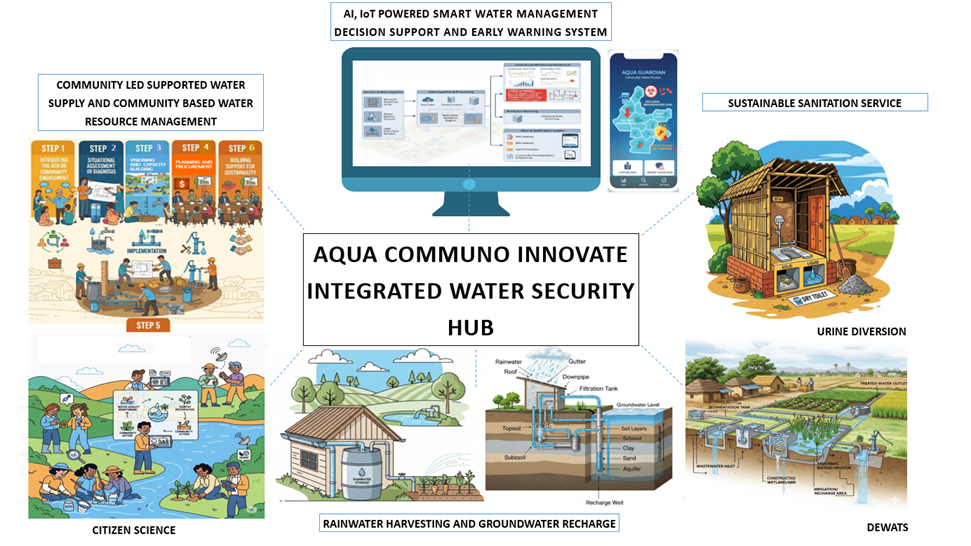
Figure 1: Aqua Communo Innovate – Integrated Water Security Hub
Our solution to Rural India’s challenge is the Aqua Communo Innovate Integrated Water Security Model, which is a multi-pronged approach to water security and safety that is driven by smart technology and innovation to inform decision making; community led water governance and supply; investment in diversified sources of water supply and investment in sustainable sanitation infrastructure.
1. AI, IoT Powered Water Management Decision Support System: Smart Water Monitoring and Early Warning System (Ataei et al., 2024; Slany et al., 2025)
This system uses interconnected IoT sensors to monitor water systems in real-time and applies artificial intelligence and machine learning to analyze data for smarter management and early warnings (Farhad et al., 2024). This integrated system helps detect critical groundwater levels, water quality out of ranges, leaks and also predict equipment failures, leading to optimized resource use, improved water quality monitoring, reduced water losses/wastage, and enhanced sustainability through data-driven decisions.
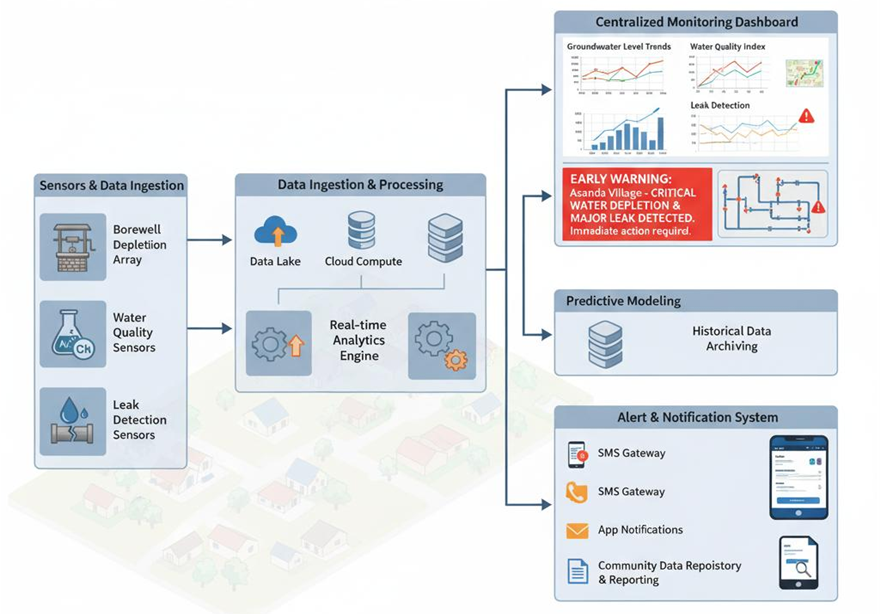
Figure 2: AI, IoT Powered Water Management Decision Support System
How the Model Works:
- IoT Sensor Monitoring Network: A network of IoT sensors is deployed throughout the water system i.e. borewels for real time acquisition of groundwater levels, water quality parameters, pressure or leaks at the distribution network.
- Physical parameters include groundwater levels, flow rate and temperature.
- Water quality parameters include pH, Dissolved Oxygen, Total Dissolved Solids, Turbidity, E. coli and Metals.
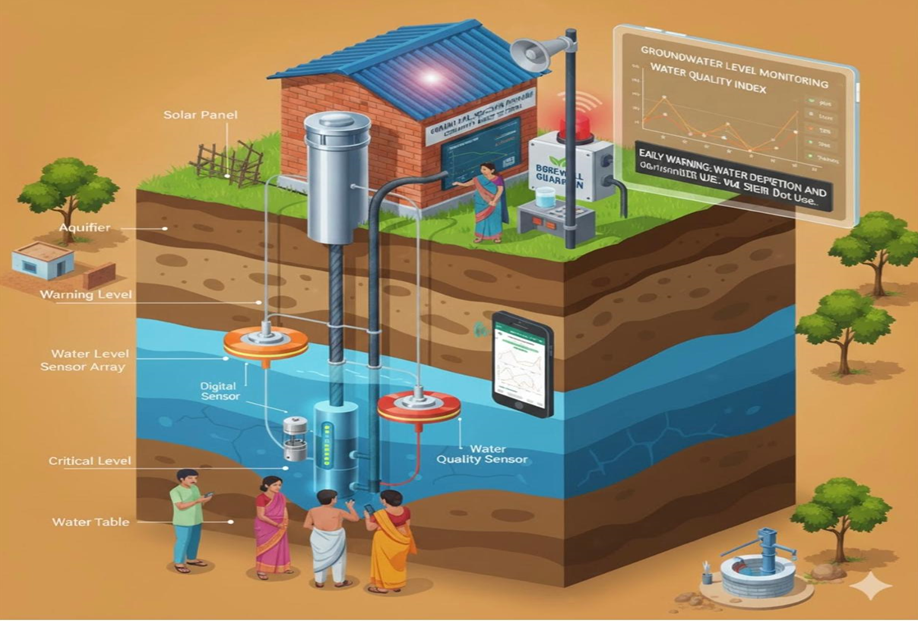
Figure 3: IoT Sensors for real-time acquisition of ground water level and quality
- Data Transmission: data collected by sensors is transmitted through a communication network such as LoRaWan or Satellite to a centralised database that is often cloud based.
- Central Database / Cloud for
- Storage of data transmitted from IoT sensors
- Provides historical data / time series for water levels, water quality, abstractions and pressure
- AI and Machine Learning Driven Analysis, Predictive Modelling and early detection. The transmitted data is fed into an AI algorithms, which use machine learning to
- Analyze patterns and identify anomalies that indicate potential problems.
- Predicts water demand based on water abstractions or water usage patterns;
- Detect low groundwater levels;
- Detect water quality parameters that are out of the specified /expected range;
- Detect leaks by identifying unusual drops in pressure and flow rates and
- Optimizes distribution.
- Decision Support and Early Warning/Alerts: The system provides actionable insights and sends automated alerts to water managers and communities for issues such as critical groundwater levels, leaks, poor water quality or potential equipment failure.
- Use analyzed data and automatically triggers alerts when:
- ground water level drops below a critical threshold,
- water quality parameters exceeds safe limits
- a potential leak is detected.
- Use analyzed data and automatically triggers alerts when:
- Real-Time Early Warning / Alert Dissemination via:
- Dashboard
- SMS
- Mobile Application and
- Community Dashboard
- Communities receive instant alerts and notifications on elevated water quality, critical groundwater levels and potential leaks.
- Community Data Collection and Reporting
- Communities are able to collect data using a mobile application and the app feed data to the central database;
- Communities and other users can report leaks, contamination, and water shortages easily using the mobile application.
- Data Insight
- Authorities access dashboards for supply/demand and maintenance related decision making.
- Communities and authorities are empowered with timely, actionable information.
AI-IoT Powered Smart Water Monitoring and Early Warning System-Website Dashboards
While the back end of the proposed smart water monitoring system is still at a conceptual phase, we have since developed a web-based plartform for data capture, data storage, data analysis, and viewing of alerts. Communities are also able to capture their citizen science data and the images below demonstration how our web-based palrtform looks like.
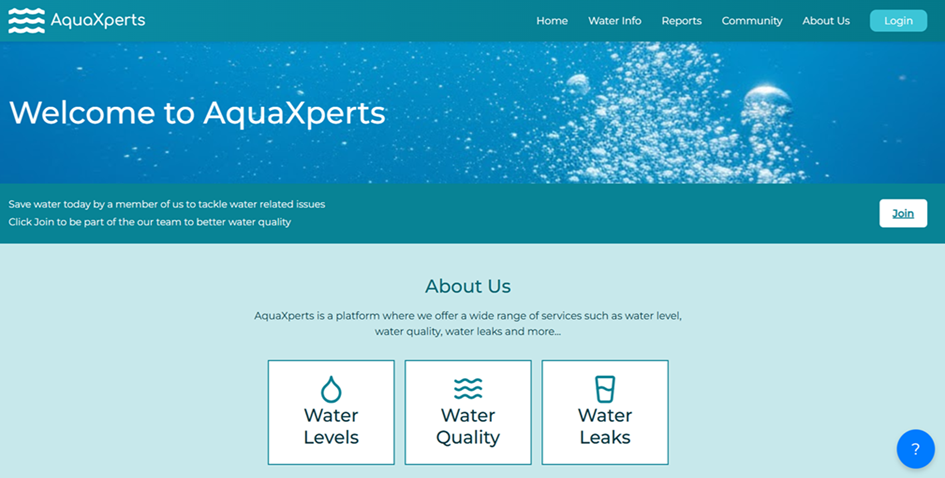
Figure 4: Dashboard showing the web based platform menu for accessing ground water levels, water quality and water leaks.
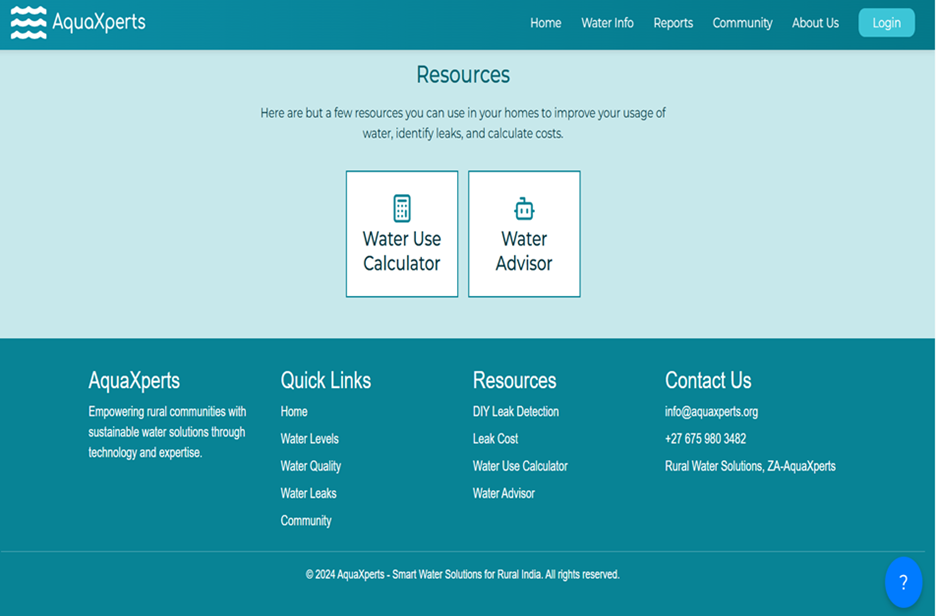
Figure 5. Dashboard showing the web-based partform menu for calculating water use and for advising on what action needs to be taken.
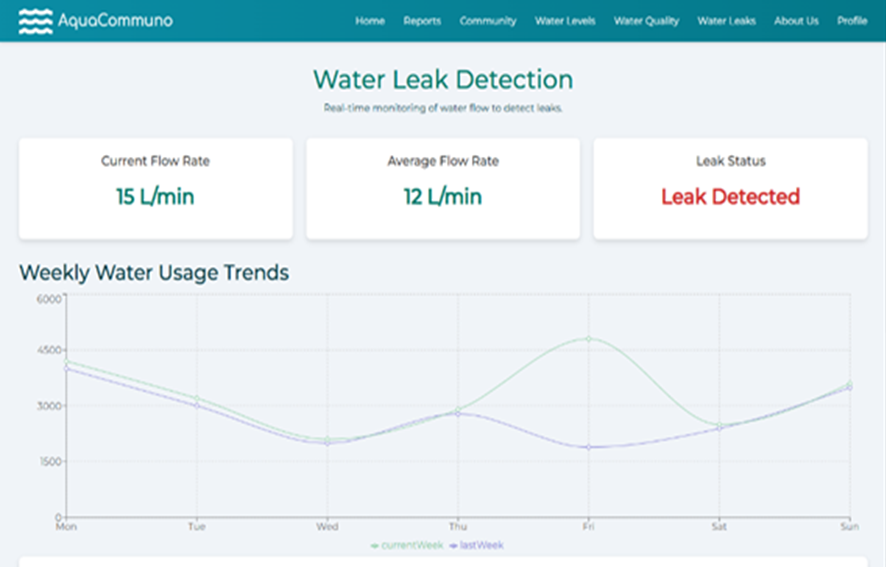
Figure 5. Dashboard showing the web-based partform outputs form water leaks status/trends.
We believe that our system will help the Indian Local Water Authorities, industries, and farmers make more informed, data-driven decisions to address the water security crisis and infrastructure maintenance challenges in India.
2. Integrated Decentralized Water Supply – Community Led Water Supply and Water Stewardship
To support the achievement of SDG 6 our integrated solution recommends the adoption of the community led supported self supply and water stewardship model.
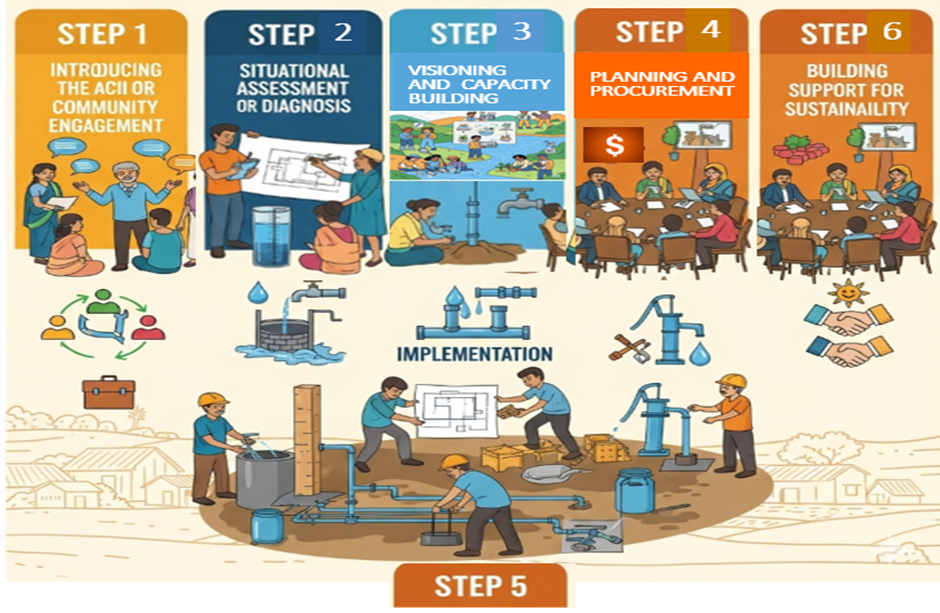
Figure 6: Integrated Decentralised/Community Led Water Supply and Water Stewardship
The Community Led Supported Self Supply and Water Stewardship model is a holistic, participatory, cost-effective, and empowering and poverty reduction focused approach to planning and providing water supply services. The approach aims ensure access to clean, reliable and sustainable water supply to all rural communities of India in alignment with SDG6. he approach considers and promotes local people’s self-supply initiatives to meet their different water demands. A similar model has been successfully implemented in South Africa by the Water Research Commission and partners, where communities took a leading role in the planning, designing, co-financing, implementing, operating and of their water supply schemes.
By design, the proposed Community Driven Supported Self Supply Model recognizes that communities:
- are resourceful when given the necessary support and platform to lead their own water supply;
- can be able to solve their water issues if they are provided the necessary support;
- know their water sources very well and as such they are best placed to be the ones who also manage and protect them; and lastly,
- the model recognizes that communities know their water needs, but it is by how they are engaged and how institutions work with them to bring out this resourcefulness as a solution to the table.
As Aqua Experts, we propose that the Government of India, implements the Supported Self Supply model at community level through a partnership between various stakeholders, including:
1) the Local Communities that have taken some initiative or that will take an initiative to put together money (co-finance) to implement their own water supply system;2) the Indian Central Water Commission (CWC) or similar (similar to the Water Research Commission in SA) that can collaborate with an 3) experienced International non-profit water research institution such as International Water Management Institute (IWMI) to put together a proposal to the funders or donors that are interested on the community driven water supply initiatives such as the Asian Development Bank (ADB) requesting financial aid to support a rural community led water supply initiatives where communities have already taken an initiative or would take the initiative to raise funds to finance their own water supply (notably, also unserved communities can be intentionally identified and be introduced to the ACI model and be offered support); 4) Local Non-Governmental Organization (NGO) such as India’s Watershed Organization Trust which has got presence in several Indian states and works to improve clean water and sanitation, focusing on community led approaches and water conservation; 5) sector Departments such as the Ministry of Jal Shakti’s Department of Drinking Water and Sanitation (DDWS) which focuses on Rural and Urban Water Supply and sanitation, the Department of Water Resources, River Development and Ganga Rejuvenation which manages broader water resource issues as well as the Department of Agriculture and Farmers Welfare to ensure that the adoption of the Supported Self Supply model does not only reside with the CWC but is passed on to the other Indian States/Provinces as a model of implementation; and most importantly, 6) the partnership needs to work with the Local Authority/Municipality or mandated local Institution such as the Jal Jeevan Mission (which focuses on providing safe, adequate tap water to all rural households) to:
- introduce an alternative water supply service delivery model which does not aim to replace the existing government Bulk Water Supply Model (BWSM), but work to augment it, considering the limitations of Government that have resulted in significant water supply backlogs, especially in the rural parts of India;
- ensure that the local authority can mobilize donor funding to support the self-supply programme with various aspects, including supporting the community driven self-supply initiative with equipment’s and capacity building on the technical aspects of self-water supply such as water resource monitoring (quality and quantity); operation of a Water Treatment Facility in applicable cases; lab analysis of water quality data; analysis of water abstractions; water conservation and demand management and establishing, operating and maintaining an Integrated Water Resource Management Decision Support System (integrating water quality and hydrological parameters) for archiving, analyzing water resource data such as aquifer levels, river levels, water abstractions, rainfall depth, water loses, water quality and also for providing hydraulic and water quality modelling functionalities for simulating the impacts of land use on water resource health and inform decision making on prioritization of interventions.
The 6 Steps of implementing the Aqua Communo Self Water Supply Model
Step 1 – Introducing the Supported Self Water Supply Model (Community Consultation
After obtaining grant/donor funding, the Aqua Communo Innovate supported self-water supply process starts with the consultation of the respective community that has initiated a self-water supply project i.e. The Central Water Commission in collaboration with the relevant project partners can first introduce the project to the Panchayats (community/village leaders and traditional council) explaining what the project is about? who is funding it? what is it intention? and explaining how the process is going to unfold from planning to implementation. During this introduction and consultation phase there are discussions about the community water sources; what they are being used for and how the community manage it water sources.
During this stage the following can also be considered:
- Identification of motivators by understanding the economic, health, and social factors that will encourage households to invest their own resources, such as saving time from fetching water or providing a safer supply for livestock, and
- Introduction of options through presenting a range of suitable technologies and service levels that households can choose based on their budget and needs.
Step 2 – Situation Analysis / Diagnosis
This is a stage where the Central Water Commission in collaboration with partners is getting to understand the challenges that the community is facing i.e. India is facing a challenge of surface water contamination caused by among other things open defecation (lack of adequate dignified sanitation); agricultural runoff; poor water resource management and climate change. Rural India is also facing a challenge of water scarcity and over-dependence on groundwater or borewells which has resulted in ground depletion and contamination due to over-abstraction. Water loses and non-revenue water is also a serious challenge in rural India due to lack of effective community-based water conservation and demand management.
Step 3 – Solution Visioning and Capacity Development
At this stage, it is where the Central Water Commission in collaboration with partners finds out from the community what does the new dawn or success look like for them? What do they see as a solution to the problem and what will they use water for. The most important thing to note at all the stages is that communities become the center of how the process of implementing the programme unfolds.
At the diagnosis stage the CWC is essentially already starting to develop capacity for the community to be able to look after (maintain) the water sources themselves or the infrastructure that supported Self Water Supply programme is going to implement.
At this stage, the project team is also thinking about what is needed? What are the technical solutions needed? Are the pipes needed? Is a small water treatment plant needed to treat unacceptable source water quality parameters? (the small treatment process is recommended if there are significant water quality non-compliances with the drinking water standards of India. the results will determine the type of treatment process that is required-whether basic of comprehensive) What is needed for use to be able to solve the water supply problem?
Step 4: Planning
After the situational analysis or diagnosis has been undertaken, the Planning stage begins. This is where the Central Water Commission in collaboration with key stakeholders is actually sitting with the communities to discuss how they going to go about implementing the project? Who will be responsible for what? How is reporting going to be undertaken? How are the external contractors going to be held accountable? Which part of the project implementations is going to be undertaken by the community? Is it excavation; is it carrying material that will be utilised for construction or pipeline? At the planning phase, it is where the team also starts to have real conversation about budget planning i.e. what financial resources will be required? What is the donation total amount or the total budget that is coming from the project donors? How much contribution is going to come from the community? Is there financial contribution that will come from the Jal Jeevan Mission? If yes, how much? How is the budget going to be spent/allocated? What is the scope of the project or activities that will need to be implemented? Will there be a need to procure material? Will the procurement be done locally? Is it going to be done through the CWC? Is it going to be a centralised one or is it going to be a decentralised one? But also in the process, who is going to be managing receiving of materials when they are being delivered in the community? Is the community expecting to be paid for this? Or these become their in-kind contribution to the project? As can be seen, this is a long engaging/participatory process where the project supported are taking communities with them. It’s about better ownership, involvement and real participation, because the communities are involved in every step of the project cycle.
The planning stage also focuses on empowering the community with the tools and knowledge to make informed decisions and mobilize resources, such as:
- Provide technical training and resources so that households can select and plan for implementation of their water supply scheme. This could include training on manual drilling techniques or best practices for well protection.
- Establishing mechanisms to help households finance their investments. This may involve setting up micro-loans, matching grants, or facilitating local savings groups; and
- Partnering with and train local service providers such as artisans, drillers, and mechanical fitters. This stimulates the local market for water supply products and services.
Step 5 – Implementation
This is the phase where the physical construction or upgrading of water supply systems takes place and is guided by the support team but largely executed by the community and local contractors. At this stage:
- The implementation is led by the community, where the community or individual households manage the construction process, often contributing financially or through in-kind labor.
- The project supporters provides oversight and technical supervision to ensure the quality of the work and adherence to health and safety standards.
The Community Water and Sanitation Committee (WASHCO) is established for communal system or as a support network for individual households to lead the initiative on behalf of the whole community.
6 – Building Support for Sustainability
The last stage of the ACI supported self-supply model looks at how is sustainability of the initiative going to be built? How are the water resources going to be monitored? How does the community know if they have over-pumped the borewell and need to give it time to recover? How much time will be required for the borewell to recover? How is water quality going to be monitored? Will the Jal Jeevan Mission be able to provide support with water quality monitoring of an ongoing basis or will they need to train selected community members on water resource monitoring? All that takes building these capacities, training communities on how to be better managers of their water supply system themselves.
This is also a critical stage for deciding on who is going operate and maintain the water supply infrastructure in the long term? What components are going to be led by the community? And what support will come from the Jal Jeeven Mission? Should the Jal Jeevan mission have difficulties or constraints with providing long term support, how are the key technical skills going to be transferred to the community and how is the community going to pay for the resources that will be trained to look after maintenance in the long term? After construction, the project’s focus shifts from physical infrastructure to institutional and managerial sustainability. This include ensuring:
- Operational training which includes training the WASHCO or households on the day-to-day operation and minor repairs of the installed systems (community based water conservation and demand management using citizen science tools such as simple leak detection methods and mobile application like the SA Field Survey App for capturing data collected by Citizen Scientists;
- Financial management which includes providing training on collecting tariffs, managing finances, and establishing a fund for major repairs and future upgrades;
- Water quality testing which includes providing support to households or citizen scientists to monitor the quality of their drinking water to ensure it is free from contamination.
At this stage, it is also critical to discuss the alternative sources of supply since in India there is overreliance on ground-water (borewells), while there is also a challenge of groundwater depletion. The community, supported by the technical project team can decide whether or not they also augment their supply with rainwater harvesting and ground water aquifer recharge, which is highly recommended by the proposed solution. Furthermore, since there is minimal use surface water due to contamination by open defaecation and various land uses the community can be trained on Community Based Integrated Water Resource Management where they can use citizen science tools and work with various landusers to ensure that water resources are protected from the different sources of pollution and to ensure implementation of restoration interventions using Nature Based Solutions (NBS) in collaboration with various stakeholders. As part of this, the community and the Jal Jeevan Mission may be assisted with developing a simple integrated catchment management and ecological restoration plan that would guide prioritisation and implementation of interventions.
Community-Based Water Stewardship and Integrated Resource Management Supported by Citizen Science
To ensure water security (availability of sufficient water that is fit for purpose) and sustainable water supply, the water supply model recognizes the current poor status of India’s water resources (both ground water and surface water) in response fosters the adoption of community led water stewardship and integrated water resource management that is driven by partnership between various stakeholders (NGOs, Water Utilities, Agriculture, Industry and Communities) and the use Citizen Science for source water health monitoring, protection, conservation and sustainable management to ensure sustainability of water supply and to foster community ownership of their water resources.
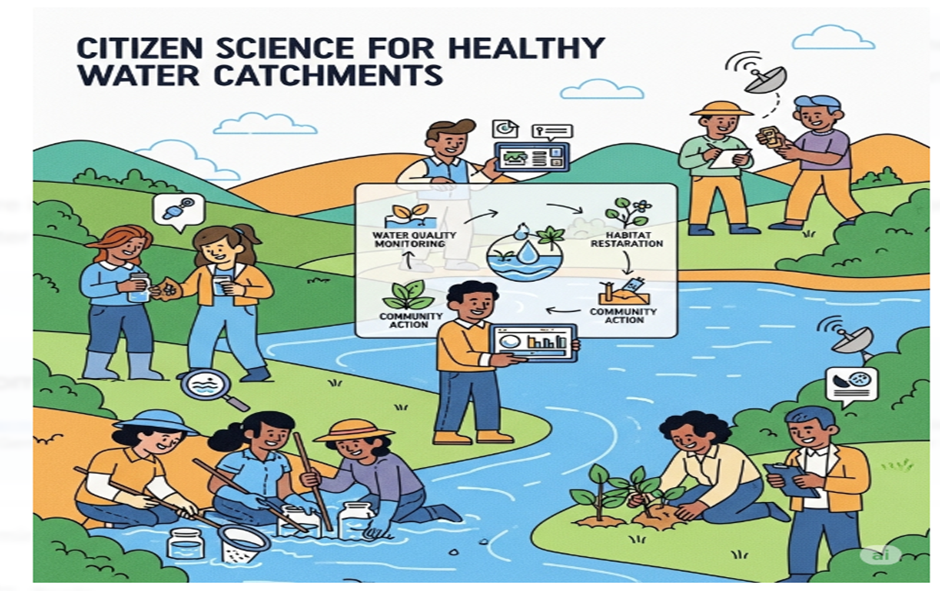
Figure 7: Community Based Water Stewardship or Water Resource Management using Citizen Science
3. Rainwater Harvesting and Groundwater Recharge for Diversified Sources of Water Supply.
The integrated water security hub/model also acknowledges the current unsustainable high reliance of India on ground water resources for different water uses and in response propose the adoption of rainwater harvesting by different was users so as to diversify the sources of water supply. The water harvested from rainfall would be used for washing clothes as well as agriculture while the borehole water would be prioritized for drinking purposes. Additionally the water harvested from rainfall would be used to replenish the depleting/depleted ground water aquifers and ensure continuous and reliable water supply to communities.
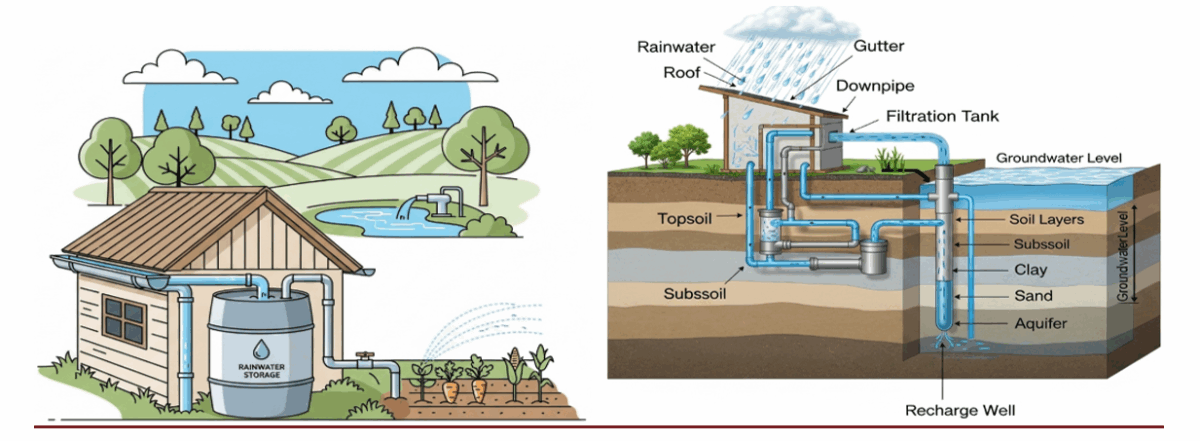
Figure 8: Rainwater Harvesting and Ground Water Recharge for Diversified Sources of Water Supply
4. Sustainable Sanitation Services/Solutions
Open defecation in rural India, driven by a lack of safe sanitation, causes significant water pollution, making resources unsafe for domestic use (WHO, 2024). Runoff from open defecation spreads fecal pathogens into groundwater and surface water, which can lead to waterborne diseases like cholera and dysentery (WHO, 2024; Okullo et al., 2017). This not only contaminates drinking water sources but also poses other health risks, like increased exposure to diseases for those in contact with the contaminated water (WHO, 2024). In order for India to sustainably tackle its water security crisis, sustainable sanitation infrastructure solutions need to be considered. This requires a holistic approach that includes investing in infrastructure, enforcing regulations, promoting water-saving technologies, and changing community behavior to protect and manage water resources effectively (UN, nd). Our proposed sustainable sanitation options for rural India include Dry Sanitation for regions where water scarcity is serious challenge and Decentralised Wastewater Treatment Systems, for the regions where water availability is not a challenge.(circular water economy) But then what is Dry Sanitation? and what are Decentralised Wastewater Treatment Systems? The sections below provide simple explanations to the two proposed sustainable sanitation options.
Dry Sanitation
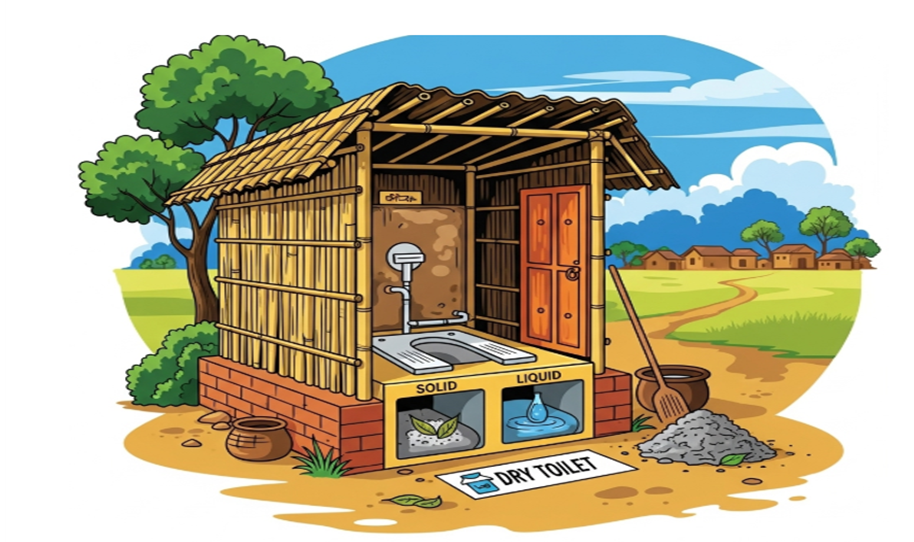
Dry Sanitation systems are waterless systems for managing human waste (Aburto-Medina et al., 2020), where excreta fall through a drop hole into a receptacle and is then composted using dry, carbon-rich material like sawdust (Climate Action Accelerator, 2025). This process breaks down the waste, reduces odors, and can produce a nutrient-rich soil amendment or fertilizer, making them a sustainable option, particularly in areas with limited water access (Climate Action Accelerator, 2025). Unlike traditional toilets, they don’t use water for flushing or connect to sewage systems, offering significant water conservation and reduced environmental pollution. These innovated toilets come in various forms, from simple bucket designs to more sophisticated models, and can be either non separating (collecting faeces and urine together) or separating (diverting urine from faeces) [Climate Action Accelerator, 2025]. Notably, dry toilets are an ecological and economical alternative to conventional toilets as they do not require water to operate. They are highly recommended for Rural India to ensure access to safe and resilient sanitation since India is a water-scarce country that still relies on open defecation which has implication for contaminating water resources. Human waste from dry toilets can also be turned into a natural fertiliser and support local agriculture, thereby integrating circularity and sustainability into satiation management (Climate Action Accelerator, 2025; UNESCO, 2019).
Decentralised Wastewater Treatment Systems (DEWATS)
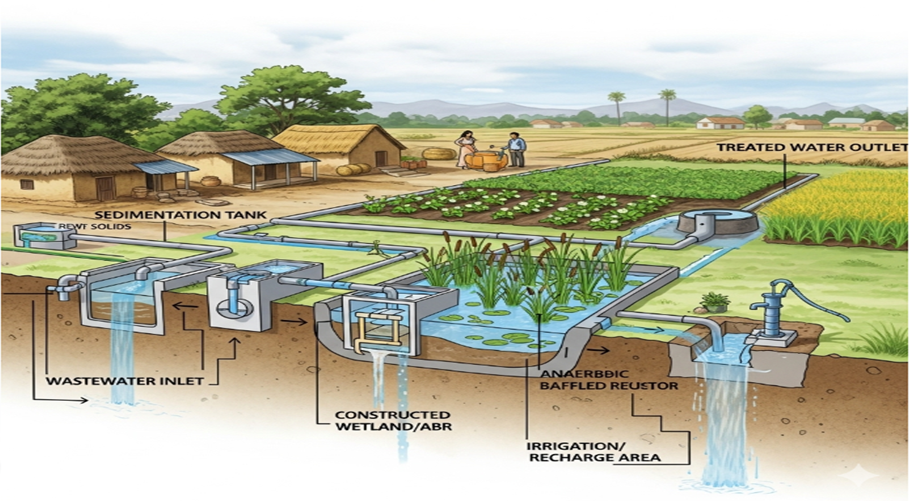
Figure 9: Decentralised Wastewater Treatment Systems as a sustainable solution to safe sanitation.
Decentralised Wastewater Treatment Systems sewer based systems that treat and reuse or disperse wastewater at or near the source of generation, such as individual homes, small communities, or businesses, rather than collecting it and sending it to a large, distant central wastewater treatment facility (SUSBIO, 2025). These systems offer a cost-effective, flexible, and sustainable alternative, especially for rural, peri-urban, and remote areas lacking centralized sewer networks (Ventura, 2024). They leverage natural based solutions or processes such as soil filtration and biological activity to treat water, reduce pollution, protect public health, and recharge local groundwater where applicable. DEWATS range from simple septic tanks to more complex systems like constructed and waste stabilization ponds. The most important thing that make these systems suitable for Rural India is that these systems use no chemicals and no electricity in their treatment process, while they use nature based solutions and promote circularity through reusing treated effluent for agricultural purposes or recharge industrial purposes.
Proposed approach to adopting sustainable sanitation infrastructure in India
The local government of India and collaborate with an international NGO such as BOARDA India, to assist with the implementation of both dry sanitation and Decentralised Wastewater Systems where practical to address the issue of lack of safe and dignified sanitation infrastructure and address the issue of water resource protection at the same time.
In conclusion, we believe that our proposed comprehensive solution, the Aqua Communo Innovate Integrated Water Security Hub or Model has the potential to resolve water security and safe water supply backlogs in rural India. The proposed solution is a holistic, innovative, inclusive, participatory, cost-effective, sustainable and poverty reduction focused approach to planning and providing water services that considers and promotes local people’s self-supply initiatives to meet their different water demands. As such, we recommend for the Jal Jeevan Mission to implement the proposed solution and we are happy to provide more information and long term advisory support should there be a need during implementation.
Business Model
Our Business Model for the Integrated Water Security Hub/Model for rural India adopts a multi-pronged approach combining public-private partnerships, community participation, and innovative financing to ensure financial viability and long-term sustainability. Key components include a “user-pays” model or co-financing with tiered tariffs for water and sanitation, microfinance for water-saving technologies, public-private partnerships for infrastructure, and convergence with government schemes like the Jal Jeevan Mission. Revenue generation will come from from services like licensing and subscription to the water resource management decision support system, operation and maintenance of the system and capacity building to different users.
Business Canvas
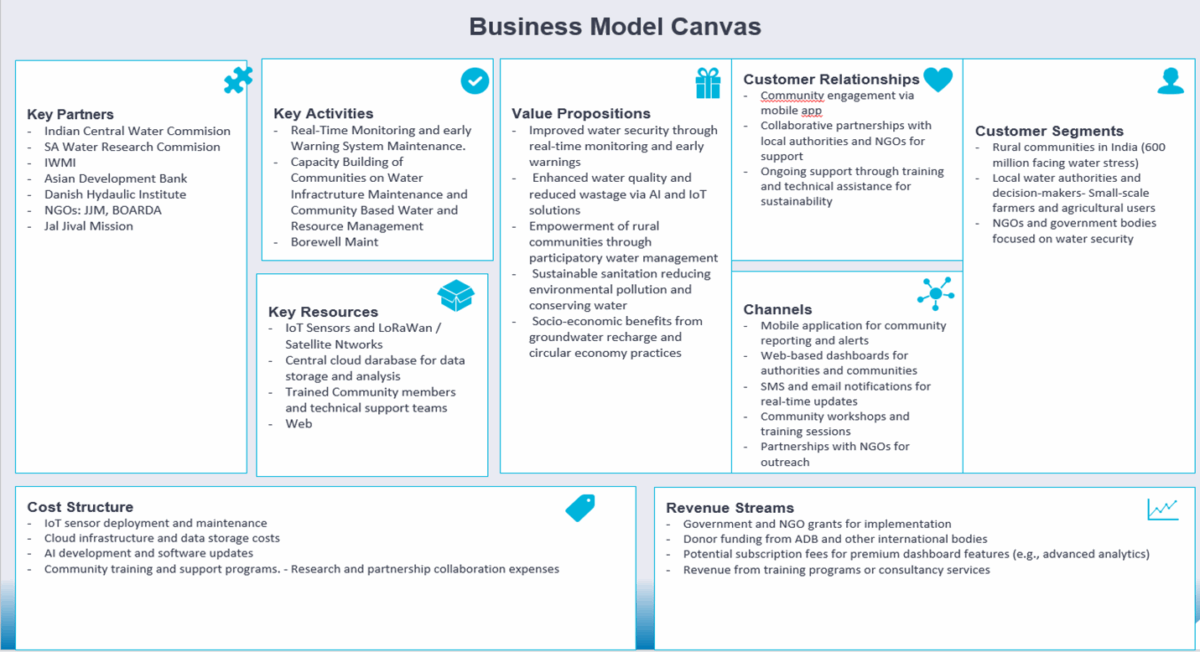
Reference
Aburto-Medina, A, Shahsavari, E. Khudur, L.S. Brown S. and Ball, A.S. 2020. A Review of Dry Sanitation. Sustainability 12(14), 5812
Ataei,P. Takhtravan, A. Gheibi, M. Chahkandi, B. Framarz, MG. Waclawek, S. Fathollahi-Fard, A.M. and Behzadian. 2024. An intelligent decision support system for groundwater supply management and electromechanical infrastructure controls. Heliyon. 10:3(2024).
Climate Action Accelerator. 2025. Dry Toilets. Accessed 25 October 2025. Available here.
Forhad, H.M. Md. Kamruzzaman R.U.S, Sharmin. R.S.C.N, Ruhul A.M. Faruk, Shofiul Islam Molla Jamal, H.M. Mezba-Ul Haque, AHM and Morshed A.K.M.M. (2024) IoT based real-time water quality monitoring system in water treatment plants (WTPs). Helion 10 (2024).
Jones, S. et al. (2020). Challenges of Rural Water Infrastructure. Journal of Sustainable Water Systems, 15(3), 45-57.
Kirkland, M. (2025). IoT for Smart Water Management: Optimize Usage and Reduce Waste
Okullo, J.O., Moturi, W.N. and Ogendi, 2019. Open Defaecation and its Effects on the Bacteriological Quality of Drinking Water Sources in Isiolo County, Kenya. Environmental Health Insights.
Patel, A. & Sharma, N. (2021). AI-Powered Smart Water Management for Developing Regions. Proceedings of the IEEE IoT Conference, 22(1), 78-89.
UNESCO, ‘The United Nations world water development report 2019: leaving no one behind’, UNESCO, 2019, Available here, (accessed 2 October 2025).
Slany, V., Krcalova, E.’ Balej, J., Zach, M., Kucova, T., Orauzek, M., an Martinek, R. 2025. Smart Water-IoT: Harnessing IoT and AI for Efficient Water Management. 57:12(2025).
SUSBIO, 2025. What are Decentralized STPs and How Are They Different from Centralized STPs?. Accessed 25 October 2025. Available here.
United Nations, nd. Sustainable Development Goal 6: Clean Water and Sanitation.
United Nations Development Programme (2019). Sustainable Development Goal 6: Clean Water and Sanitation. Retrieved from.
Ventura, J.S., Tulipan, J.U., Banawa, A., Umali., K.D.C., and Villanueva, JAL. 2024. Advancements and challenges in decentralized wastewater treatment: A comprehensive review. Desalination and Water Treatment.320:2024
World Bank. (2011). Towards Drinking Water Security in India: Lessons from the Field.
World Health Organization (2022). Global Water Crisis Report. Retrieved from https://www.who.int/water-crisis-report
World Health Organization and UNICEF. (2023). Progress on Household Drinking Water, Sanitation, and Hygiene 2000-2022: Special focus on gender.
World Health Organization. (2024). Sanitation. https://www.who.int/news-room/fact-sheets/detail/sanitation#:~:text=Poor%20sanitation%20is%20linked%20to%20transmission%20of,contributes%20to%20the%20spread%20of%20antimicrobial%20resistance.
https://www.undp.org/sustainable-development-goals/clean-water-and-sanitation
Meet the Team

Ntombifuthi Vilakazi
University of KwaZulu-Natal
PhD Hydrology
I have experience in Water Security, water and sanitation supply, Integrated Water Resource Management, Climate Change resilience and Nature Based Solutions.

Keaobaka Mahoko
North-West University
PhD Environ Sciences and management
Water quality monitoring and management specialties. Current interests involve integrated hydrological and crop growth modelling.

Thato Elvis Ramotsabi
Sol Plaatje University
MSc Data Science
My core competencies lie at the intersection of human-computer interaction, data analysis, and sustainable technology development.

Dzanga Rambuda
University of Mpumalanga
Bachelor of Information and Communication Technology Honors
Data analytics, machine learning, and computing with a focus on applying intelligent systems to complex challenges

Qininso Ntshingila
University of Mpumalanga
MSc Computing
I have broad knowledge in integration IoT devices with cloud, and I have worked on small projects that deal with testing water quality using IoT.
